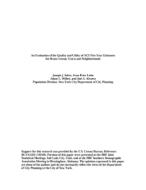An Evaluation of the Quality and Utility of the ACS Five Year Estimates for Bronx Census Tracts and Neighborhoods
An Evaluation of the Quality and Utility of the ACS Five Year Estimates for Bronx Census Tracts and Neighborhoods
Introduction
The American Community Survey (ACS) conducted its first full-scale national data collection in 2005, following nearly a decade of pilot-testing in selected counties across the nation, and after successfully fielding large national samples to demonstrate the operational feasibility of the program. ACS estimates will replace those from the decennial census long-form, thus becoming the nation’s primary source of socioeconomic data for all geographic areas.1 The ACS plan calls for data collection from approximately 250,000 housing units every month, or from 3 million units annually, with samples averaged to derive annual estimates for all geographic areas of the nation of at least 65,000 persons. For smaller areas, ACS estimates are created from 3 year samples (for places of 20,000 to 65,000) and from five year samples (for areas of under 20,000).
The ACS represents a significant departure from the decennial census, especially with respect to the form and scale of data collection. The census employs a “usual residence” concept, while the ACS is based on residence of at least two months at the time of interview. The 2000 Census enumerated over 105 million households, including nearly 18 million that received the long-form, over a period lasting about six months (using an April 1 reference point). Follow-up was done on all non-responding households using a large group of temporary workers. In comparison, the ACS employs a pool of experienced interviewers to follow-up a one-in-three subsample of units not responding by mail or telephone.2 Estimates are derived from pooling successive monthly samples, as opposed to data collected using a single point-in-time reference, as in the decennial census.
While the ACS provides more timely data at regular intervals, the ACS sample is smaller than that of the decennial long form. As a result, ACS estimates are subject to higher levels of sampling variability than their 2000 Census long form counterparts (Citro and Kalton, 2007). The key question for data users is whether the utility of these estimates for small areas is maintained, despite larger standard errors. Thus far, research with threeyear estimates in selected parts of the nation has indicated that the ACS has the potential to serve as a replacement for the census long form at the county level (Salvo et al., 2004; Hough and Swanson, 2004; Van Auken et al., 2004; Gage, 2004; Diffendal et al., 2004). With the advent of the five year estimates, it is now possible to examine the utility of tract level estimates. Such an evaluation also needs to take into account the goals and requirements of individual data applications, since the level of precision required varies across applications. This paper conducts such an evaluation.
Download the Presentation
Others in Series
Working Paper
Working Paper
Working Paper





